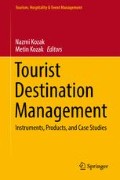Abstract
Tourism as a socio-economic phenomenon, combines market aspects of economic relations and social-oriented society’s development objectives. In the contemporary environment for tourist industry development destination is a key element of tourism system, particularly manifested all interconnections and interdependencies of a given system with external socio-economic environment at the regional level. Furthermore, we monitor a need to replenish the theoretical and methodological destination analysis foundations as well as improvement of the mechanisms of its practical application.
Access this chapter
Tax calculation will be finalised at checkout
Purchases are for personal use only
References
Bachvarov, M., & Tonchev, T. (2007). Basics of tourism. Sofia: Tilia. (In Bulgarian).
Bekhtereva, N. P., Bundzen, P. V., Kaplunovsky, A. S., & Matveev, Y. K. (1971). Functional organization of activity of cerebral neuronal assemblies in humans during short-term verbal memory. Sechenov Physiological Journal, 57(12), 1605–1621. (In Russian).
Cooper, C., Fletcher, J., Fyall, A., Gilbert, D., & Wanhill, S. (1993). Tourism: Principles and practice. Harlow: Pearson Education.
Cohen, E. (1972). Towards a sociology of international tourism. Social Research, 39, 164–182.
Child, D. (2006). The essentials of factor analysis (3rd ed.). New York: Continuum International Publishing Group.
Cho, D. S. (1998). From national competitiveness to bloc and global competitiveness. Competitiveness Review, 8(1), 11–23.
Crouch, G. I., & Ritchie, J. R. B. (1999). Tourism, competitiveness and societal prosperity. Journal of Business Research, 44, 137–152.
Dwyer, L., & Kim, C. W. (2001). Destination competitiveness: Development of a model with application to Australia and the Republic of Korea. Report prepared for Department of Industry Science and Resources, Australia and Korea Tourism research Institute, Unpublished Report. University of Western Sydney, Sydney.
Dwyer, L., & Kim, C. W. (2003). Destination competitiveness: Determinants and indicators. Current Issues in Tourism, 6(5), 369–414.
Dwyer, L., Livaic, Z., & Mellor, R. (2003). Competitiveness of Australia as a tourist destination. Journal of Hospitality and Tourism Management, 10(1), 60–79.
Dwyer, L., Mellor, R., Livaic, Z., Edwards, D., & Kim, C. (2004). Attributes of destination competitiveness: A factor analysis. Tourism Analysis, 9(1–2), 91–101.
Field, A. (2009). Discovering statistics using SPSS: Introducing statistical method (3rd ed.). Thousand Oaks, CA: Sage.
Giannakopoulos, X., & Valpola, H. (2001). Nonlinear dynamical factor analysis. In Bayesian inference and maximum entropy methods in science and engineering. AIP Conference Proceedings, 568, 305.
Goodrich, J. N. (1977). Differences in perceived similarity of tourism regions: A spatial analysis. Journal of Travel Research, 16, 10–13.
Gorsuch, R. L. (1983). Factor analysis (2nd ed.). Hillside, NJ: Lawrence Erlbaum Associates.
Haahti, A. J., & Yavas, U. (1983). Tourists’ perceptions of Finland and selected European countries as travel destinations. European Journal of Marketing, 17(2), 34–42.
Hong, S., & Harshman, R. A. (2003a). Shifted factor analysis – Part II: Algorithms. Journal of Chemometrics, 17, 379–388.
Hong, S., & Harshman, R. A. (2003b). Shifted factor analysis – Part III: N-way generalization and application. Journal of Chemometrics, 17, 389–399.
Heij, C., & Scherrer, W. (1997). System identification by dynamic factor models. SIAM Journal on Control and Optimization, 35(6), 1924–1951.
Jafari, J. (1986). Systemic view of sociocultural dimensions of tourism (pp 33–50). In the President’s Commission on Americans Outdoors.
Jensen, C. F. (1997). The dynamic destination. A resource based perspective of tourism. Edinburgh: Congress Paper.
Jöreskog, K., & Sörbom, D. (1996). LISREL 8: Users reference guide. Hillsdale, NJ: Lawrence Erlbaum Associates.
Jurowski, C., Uysal, M., & Williams, D. R. (1997). A theoretical analysis of host community resident reactions to tourism. Journal of Travel Research, 36(2), 3–11.
Kozak, M., & Rimmington, M. (1999). Measuring tourist destination competitiveness: Conceptual considerations and empirical findings. International Journal of Hospitality Management, 18(3), 273–283.
Kim, J., Klekka, U. R., & Muller, C. U. (1989). Factor, discriminant and cluster analysis. Moscow: Finance and Statistics. (In Russian).
Lawley, D. N., & Maxwell, A. E. (1962). Factor analysis as a statistical method. Journal of the Royal Statistical Society. Series D (The Statistician), 12(3), 209–229.
Leiper, N. (1995). Tourism management. Melbourne: RMIT Press.
Loehlin, J. C. (1987). Latent variable models: An introduction to factor, path and structural analysis. Hillsdale, NJ: Lawrence Erlbaum Associates.
Murphy, P. E. (1985). Tourism: A community approach. New York: Methuen.
Narashima, S. (2000). Organization knowledge, human resource management and sustained competitive advantage: Toward a framework. Competitiveness Review, 10, 123–135.
Pearce, D., Moscardo, G. M., & Ross, G. F. (1996). Tourism community relationship. Oxford: Pergamon.
Pearce, D. G. (1997). Competitive destination analysis in Southeast Asia. Journal of Travel Research, 35(4), 16–24.
Ritchie, J. R. B., & Crouch, G. I. (2000). The competitive destination: A sustainability perspective. Tourism Management, 21(1), 1–7.
Stankova, M. (2009). Improving the management of the tourist destination. Sofia: Avangard-Prima Publishing House. (In Bulgarian).
Stankova, M. (2013). Increasing the tourist destination’s competitiveness. Blagoevgrad: University Publishing House of the South-West University “Neofit Rilski”. (In Bulgarian).
Thompson, B. (2004). Exploratory and confirmatory factor analysis: Understanding concepts and applications. American Psychological Association.
Vasileva, I. (2006). Design of indicators for the Bulgarian economy with summarized dynamic factor models, agency for economic analysis and forecasting. K.I.B.I.2006.pdf. (In Bulgarian).
Yong, A. G., & Pearce, S. (2013). A beginner’s guide to factor analysis: Focusing on exploratory factor analysis. Tutorials in Quantitative Methods for Psychology, 9(2), 79–94.
Zuur, A. F., Fryer, R. J., Jolliffe, I. T., Dekker, R., & Beukema, J. J. (2003). Estimating common trends in multivariate time series using dynamic factor analysis. Environmetrics, 14, 665–685.
Author information
Authors and Affiliations
Editor information
Editors and Affiliations
Rights and permissions
Copyright information
© 2019 Springer Nature Switzerland AG
About this chapter
Cite this chapter
Stankova, M., Vasenska, I. (2019). Competitiveness Factor Analysis of an Operating Tourist Destination. In: Kozak, N., Kozak, M. (eds) Tourist Destination Management. Tourism, Hospitality & Event Management. Springer, Cham. https://doi.org/10.1007/978-3-030-16981-7_15
Download citation
DOI: https://doi.org/10.1007/978-3-030-16981-7_15
Published:
Publisher Name: Springer, Cham
Print ISBN: 978-3-030-16980-0
Online ISBN: 978-3-030-16981-7
eBook Packages: Business and ManagementBusiness and Management (R0)

